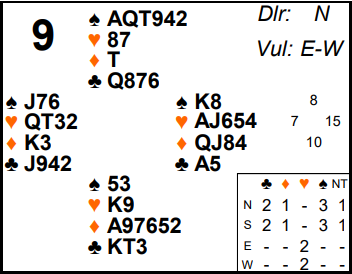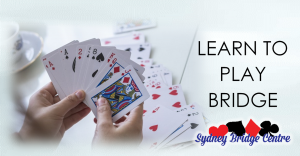City and Canada Bay – Monday Morning 17th June 2024.

Board 9 last week would most likely have seen North open a weak 2♠ and East having to decide what to do.
It’s not a nice decision. There are flaws with every bid you might consider so, as so often is the case, you have to pick the “least bad” option!
Overcalling 3♥ is pretty committal – you only have a 5 card suit and they aren’t very good. If the hearts sit over you, you are likely to be in very big trouble! Today a 3♥ overcall works out OK though.
2NT is a possibility – this should be natural (usually about 16-18) over a weak two. Here I don’t like it though for a few reasons:
- You are a bit light with only 15 points
- Your spade stopper (♠Kx) is poor
- You have a 5 card major so you might miss a fit there
Double is another option. It’s more flexible than the other options but it too has its downsides:
- Partner is very unlikely to ever bid hearts with only 3 so you will miss an 8 card heart fit
- What will you do if partner bids clubs?
This of course is why people pre-empt – to create problems! Without the 2♠ opening East simply opens 1♥ and probably rebids 2♦ if hearts are not raised. On balance I think I would double 2♠ (and if partner did bid clubs I’d simply pass and take my medicine! Unless I was playing a method called Equal Level Conversion – see advanced section).
What about South? Most likely he will pass but that may depend on the nature of his partner’s 2♠. Traditionally weak twos showed a 6 card suit and about 6-10 points. If that is the case here then South might consider competing to 3♠ as he knows the pair have an 8 card fit. But if he does that he should decide in advance what he’s going to do if the opponents bid to 4♥. Defend it and hope to beat it? Bid 4♠?
These days weak twos vary a lot more and, especially when at favourable vulnerability like here, many pairs are a lot more aggressive. It’s not uncommon to open a weak two on a 5 card suit. When you discuss system with a partner it should be far more than just what the bids mean – agreeing your style with pre-empts etc is a very important part too. What do you do at certain vulnerabilities? Do they vary if you are in 1st seat, 2nd seat or 3rd seat? See advanced section for more discussion on this. Remember that your style should be disclosed – the opponents are entitled to know it as well. It can influence South here – if North’s bid could be on a 5 card suit then South clearly won’t raise to 3♠ and will just pass and see if East West can bid accurately when they effectively have to start at the 3 level.
Suppose East does double and South passes. What about West now? 3♥ might seem the obvious bid. Well yes – except what point range does it show? If West had no points at all and this shape he would still have to bid 3♥ – he can hardly leave the double of 2♠ in. Here he has 7 points (albeit they aren’t very nice as they include two Jacks). But he could also have slightly more than that. If he bids 3♥ on a hand with 0 points and also with, say, 9 or 10 points how is East supposed to know what to do with a hand like this one – opposite 9 or 10 he probably wants to be in game; opposite 0 he will be hoping 3♥ isn’t already too high!
This is where a convention called Lebensohl can come in very useful. Basically the partner of the doubler bids 2NT as an artificial bid to show a bad hand (about 0-7). Doubler nearly always bids 3♣ over that and then partner either passes or bids his suit. (If the doubler has a really enormous hand which is too big to risk partner passing 3♣ then he does something else). The big advantage of Lebensohl comes in that NOW an immediate bid at the 3 level in response to the double shows some values (about 8-11). This gives doubler the chance to move safely if he does have a better than minimum hand.
On this hand I would still use Lebensohl with West but with the knowledge that I am maximum for my 0-7 range. As East I would bid 3♣ and then when partner bids 3♥ I’d be happy but I would still pass, knowing partner has a weak hand. Conversely had West bid 3♥ immediately showing 8+ points then NOW as East I would be tempted to try 4♥ as I have a 5th trump, some ruffing values and the ♠K probably well placed.
In previous columns I have mentioned that when you respond to a takeout double of a 1 level opening bid you need to remember you might be forced to respond with 0 points and hence when you have more than about 8 points then you need to jump in response. That enables partner to know what to do when their double is better than a minimum hand. Lebensohl is exactly the same principle – it’s just that over weak 2’s you don’t have room to safely jump the bidding in response, hence 2NT is used as an artificial bid to effectively allow you two ways to show your suit at the 3 level – one showing more values than the other.
Of course one downside of Lebensohl is you lose the ability to bid 2NT naturally. This isn’t actually a great loss though – some of the time with a hand that might have wanted to do that you can try 3NT and hope; some of the time your trumps may be good enough to consider passing and converting the double to penalties. Overall using 2NT as an artificial way to show different values at the 3 level is more useful than being able to invite in no-trumps. Which is why almost all experienced pairs play Lebensohl or variations of it in this situation.
That’s a lot of talk about bidding so let’s finish by considering the play. If East did double and West used Lebensohl then West will end up declaring 3♥. North will probably lead his singleton ♦10. South can win (what card should declarer play and why?) and give him a ruff (by leading what diamond?). See advanced section for answers to the questions. After that the defence will come to ♠A, a ruff, ♥K, ♦A and ♣K to beat 3♥ by 1 trick. If East is declaring 3♥ then South has no reason to find ♦A lead and is more likely to lead ♠5. However, North can win ♠A and immediately switch to his diamond to get his ruff. The majority playing hearts seem to have made 9 tricks though so perhaps the diamond ruff wasn’t found (maybe after ♠5 lead North returned a spade hoping the lead was a singleton?).
For those North South pairs who did play in spades the hand goes quite well. East might lead ♦Q (nothing else appeals). Declarer will now take some form of spade finesse (it’s a guess really whether to try ♠10 or ♠Q but East’s bidding probably suggests he has more points so I’d be inclined to place him with ♠K and hence try ♠10 which works on this hand). There is also a favourable club position if declarer leads towards the ♣K10x. When the ♣K holds the trick he knows East has the ♣A so he can duck on the 2nd round and the ♣A hits thin air. This will limit his losers to 1 spade, 1 heart and 2 clubs (the 4th club in North is still a loser).
Key points to note
- Bidding over weak twos can be nasty with all bids having flaws. Try to pick the “least bad”!
- Playing Lebensohl when responding to takeout doubles of weak twos allows you to show two different point ranges – almost essential to being able to bid accurately.
- It’s important to agree the style of pre-empts your partnership plays – i.e. how aggressive you are at different vulnerabilities and seats. This helps partner judge (but remember the opponents are entitled to the same information).
- As declarer if you suspect the defence are leading a singleton, consider if there is any way of muddying the waters to perhaps avoid some upcoming ruffs.
More advanced
Would you open 2♠ as North in your partnership? Your agreed partnership style here is very important. If you open a weak 2♠ on this hand and also on a much weaker hand with a 5 card suit then it’s impossible for partner to know what to do.
Many pairs these days would consider this hand too good for a 2♠ pre-empt at favourable vulnerability. Some might open 3♠! A method that is sometimes played is two strength weak twos. A 2♦ opening shows a bad weak 2 in a major (usually a 5 card suit and less than 8 points). A 2♥ or 2♠ opening then shows a better hand (usually about 8-10 with a 6 card suit). This helps partner judge what to do.
Another variation in pre-empting style occurs depending on which hand you are. It’s worth appreciating that all 4 seats are different:
- 1st seat – it’s unclear whose hand it is so the vulnerability tends to be the deciding factor for how aggressive to be.
- 2nd seat – with one opponent already a passed hand there’s a better chance that it might be your side’s hand. So you tend to want pre-empts to be sounder as you don’t want to make it harder for partner if he is the one with the big hand!
- 3rd seat – with partner having passed you (and only you) know whose hand it is. So here pre-empts can be quite wide ranging. Perhaps anything up to 11 points where you are confident your side is not making game. That makes it much harder for 4th seat (who is known to have a good hand).
- 4th seat – here there is no-one left to pre-empt! So most pairs play a 2 level opening as a more constructive bid with intermediate values – about 12-15 and a 6 card suit.
I mentioned Equal Level Conversion. This applies by a hand that has started with a takeout double (more commonly at the 1 level but it can also apply at the 2 level). It basically says that if you bid a new suit over partner’s response to your double than that is not showing any extra values, it is merely saying that your initial double was off-shape and you really only have 2 suits which don’t include the one partner bid. So on this hand if West had responded 3♣ then East might bid 3♦ to show he had diamonds and hearts. This method allows you to safely double on many more hands and hence compete more often. But note it’s very different from the traditional meaning of double and then bidding a new suit – which shows a hand that is too good to overcall that suit immediately. If you do play equal level conversion then you also need to sort out how you will bid those hands. Do you overcall on even stronger hands? Do you jump in your own suit on the 2nd round? Do you cue bid the opponents suit and then, finally, bid your own suit on the 3rd round? There are downsides to all of that – which is why equal level conversion is not the great method some think!
Lastly I posed two questions in the play of 3♥. When defending 3♥ if West is declarer after ♦10 to South’s ♦A he should smoothly drop the ♦K! This leaves open the possibility for South that North led from ♦103. Now a diamond return would let declarer get some discards on the ♦QJ. So it’s possible South will try something else and declarer may escape an immediate diamond ruff. Of course if South is giving North a ruff he should lead the ♦2 as a suit preference signal saying he wants a club switch to set up his ♣K.
Julian Foster (many times NSW representative)
work out OK.



